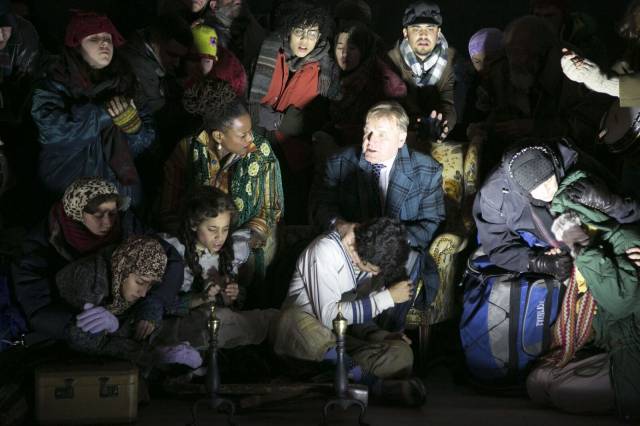

When you’re watching a play where dinosaurs and woolly mammoths are treated like modern household pets, it’s freezing cold in the middle of August, and actors continually stop mid-sentence to break character, you know you’re seeing something truly unique. Imaginatively directed by Arin Arbus, Thornton Wilder’s The Skin of Our Teeth is a wildly original, ambitious tragicomedy currently playing at Theatre for a New Audience at the Polonsky Shakespeare Center.
The Antrobus family lives in suburban New Jersey. They are a traditional household consisting of father George (David Rasche), mother Maggie (Kecia Lewis), son Henry (Reynaldo Piniella), daughter Gladys (Kimber Monroe), and maid Sabina (Mary Wiseman). However, the Ice Age is closing in on them due to a glacier moving south from Canada. The neighborhood dinosaur and mammoth are complaining of the cold. Fire and food are scarce, yet Mr. Antrobus sends a singing telegram (Jessie Shelton) to let his family know he’ll be late. He’s just made an important discovery, the wheel, and he’s invited refugees moving south on foot to stop by and warm themselves by the Antrobus’ fire. Among them are Homer (Andrew R. Butler), Moses (Robert Langdon Lloyd) and a professor (Arthur French).
Written in 1942 at the apex of World War II, The Skin of Our Teeth is a testament to the resiliency of humanity in the face of tragedy, war and natural disaster. While it makes several literary and historical allusions, the play is steeped in Biblical symbolism, specifically the Book of Genesis with references to Adam and Eve, Cain and Abel, and Noah and the Flood.
One of the most interesting aspects of The Skin of Our Teeth is that the actors constantly break the fourth wall and play themselves in a sort of play-within-the-play. This Absurdist device breaks the tension and adds a lot of humor. The character of Sabina is the one who most often slips from her Skin character to the character of Mary Wiseman, the actor who plays her. As the de facto narrator of the story, Sabina/Mary often brings the beleaguered “director” Fitzpatrick (William Youmans) out onto the stage, sometimes treating the performance as a “rehearsal.”
This production contains original music by César Alvarez, which is well-performed by a cast of 35 actors, musicians, and dancers. The set design (Riccardo Hernandez) is also quite impressive, as it changes from a suburban home to the Atlantic City boardwalk to a sort of bunker with the movement of some large set pieces. An exhilarating transition happens between Acts I and II, when the roof of the Antrobus’ house is lifted, the walls fall away, and a shimmering green fringe curtain swoops across the stage to mark the transition to Atlantic City and the frenetic vaudevillian energy that occurs throughout Act II.
Special mention must be made to the costume and puppet design (Cait O’Connor). Bright colors and crazy mismatched pattern combinations add to the highly stylized surreality of the play. The aforementioned dinosaur and mammoth, played by Fred Epstein and Eric Farber respectively, are uniquely represented by detailed mascot-like costumes.
The theatrical experience of The Skin of Our Teeth is unlike any you’ll probably have. With all its farcical and absurdist dramatic elements, Biblical allusions, topsy-turvy timeline, and musical interludes, it is a singular production with a universal human story at its core. After all, Wilder wrote it meaning to unite humanity, a sentiment all too crucial in this modern age.